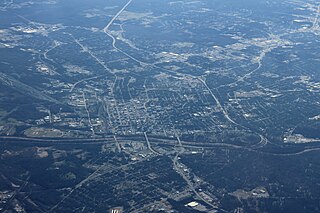
Macon, officially Macon–Bibb County, is a consolidated city-county in Georgia, United States. Situated near the fall line of the Ocmulgee River, it is 85 miles (137 km) southeast of Atlanta and near the state's geographic center—hence its nickname "The Heart of Georgia".

The Presbyterian Church in America (PCA) is the second-largest Presbyterian church body, behind the Presbyterian Church (USA), and the largest conservative Calvinist denomination in the United States. The PCA is Reformed in theology and presbyterian in government.

The Cumberland Presbyterian Church is a Presbyterian denomination spawned by the Second Great Awakening. In 2019, it had 65,087 members and 673 congregations, of which 51 were located outside of the United States. The word Cumberland comes from the Cumberland River valley where the church was founded.

Westminster Hall and Burying Ground is a graveyard and former church located at 519 West Fayette Street in Baltimore, Maryland, United States. It is currently part of the grounds of the University of Maryland's School of Law. It occupies the southeast corner of West Fayette and North Greene Street on the west side of downtown Baltimore. It sits across from the Baltimore VA hospital and is the burial site of Edgar Allan Poe (1809–1849). The complex was declared a national historic district in 1974.

The Presbyterian Church in Canada is a Presbyterian denomination, serving in Canada under this name since 1875. The United Church of Canada claimed the right to the name from 1925 to 1939. According to the Canada 2021 Census 301,400 Canadians identify themselves as Presbyterian, that is, 0.8 percent of the population.
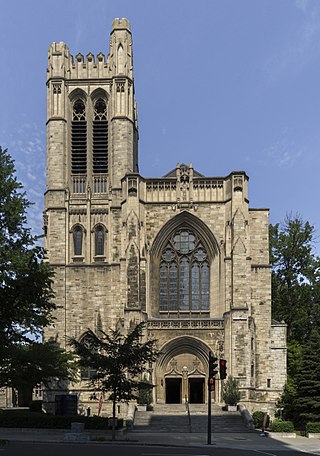
The Church of Saint Andrew and St Paul is a Presbyterian church in downtown Montreal, Quebec, Canada. It is located at 3415 Redpath Street, on the corner of Sherbrooke Street. It is in close proximity to the Golden Square Mile, the Montreal Museum of Fine Arts, Concordia University as well as the Guy-Concordia Metro station.
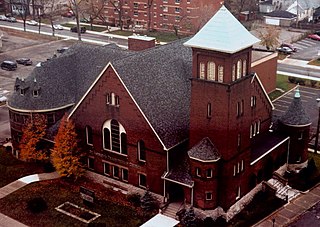
St. Andrew's Presbyterian Church, is a Presbyterian Church in Canada congregation in downtown Windsor, Ontario, Canada. The congregation dates back to 1857, and at one time, was the largest congregation by membership within the Presbyterian Church in Canada (PCC).
Warrenton Presbyterian Church is a Presbyterian Church (USA) congregation located at 133 Watts Road near Abbeville in Abbeville County, South Carolina.

Presbyterian Church of East Africa (PCEA) is a Presbyterian denomination headquartered in Nairobi, Kenya. In Kenya, 10% of the population is Presbyterian. It was started by missionaries from Scotland, most notable of whom was Dr John Arthur. It has its headquarters in Nairobi South C.
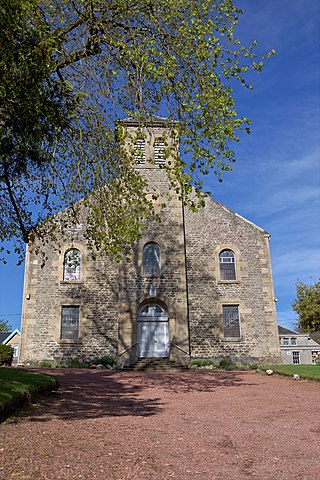
Abbeygreen Church is a congregation of the Free Church of Scotland in the small town of Lesmahagow, Lanarkshire. As a Christian congregation, it is presbyterian and reformed; holding the Word of God, the Holy Bible, as the supreme rule of life and doctrine and the Westminster Confession of Faith as a sub-ordinate standard, which helps explain the doctrines of the Christian faith. Being Presbyterian, it serves as part of the Free Church of Scotland Presbytery of Glasgow and seeks to faithfully serve God in Lesmahagow and the surrounding area. Having a missional outlook it is involved with a number of missionary organizations including, but not only, UFM Worldwide and Rose of Sharon Ministries, and helps with the organization and support of the Scottish Reformed Conference.

Downtown Macon refers to the largest financial district in the city of Macon, Georgia, United States. It is home to many museums, ranging from the Georgia Sports Hall of Fame to the Tubman African American Museum. Numerous Antebellum homes are located in Downtown Macon, including the Woodruff House, the Hay House, and the Cannonball House. One of the most notable churches in downtown Macon is Mulberry Street United Methodist Church, the oldest Methodist Church in the state of Georgia. Terminal Station, was built in 1916.

Samuel Miller was a Presbyterian theologian who taught at Princeton Theological Seminary.

The Fort Street Presbyterian Church is located at 631 West Fort Street in Detroit, Michigan. It was constructed in 1855, and completely rebuilt in 1877. The church was listed on the National Register of Historic Places and designated a Michigan State Historic Site in 1971. Its steeple stands 265 ft (81 m), making it one of the tallest churches in the United States.
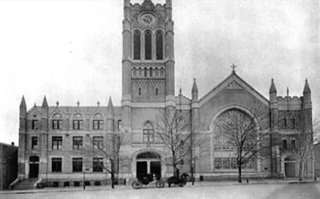
The congregation of North Presbyterian Church, at 525 West 155th Street in Manhattan, New York City, is a combination of three former congregations: North Presbyterian Church, Washington Heights Presbyterian Church, and St. Nicholas Avenue Presbyterian Church.

Saint Joseph Catholic Church , located at 812 Poplar Street in Macon, Georgia, was listed on the NRHP on July 14, 1971. The church is located in the middle of Downtown Macon and takes up one block. It is operated by the Roman Catholic Diocese of Savannah.

Washington Presbyterian Church is a historic Presbyterian church at 206 E. Robert Toombs Avenue in Washington, Georgia. The church was founded in 1790, with the building constructed in 1825. It was added to the National Register in 1972.

First Presbyterian Church in Schenectady, New York is a historic Presbyterian Church in America congregation.
Bethesda Presbyterian Church is a historic Presbyterian Church in America congregation in Edwards, Mississippi. The church was founded in 1826, and it is among the 50 oldest churches in the PCA.

St Andrew's Kirk, Launceston, is a Presbyterian church located on St John Street in Launceston, Tasmania, Australia, serving the Presbytery of Bass. It was the second Presbyterian church to be built in the city of Launceston following the Scotch National Church on Charles Street.

The Presbytery of Boston is the regional governing body for congregations located in the Greater Boston area affiliated with the Presbyterian Church (USA). Established in 1745 and with an office in Clinton, Massachusetts, the Presbytery of Boston currently includes 20 member churches located in Worcester, Norfolk, and Suffolk counties, and parts of Essex County. The Presbytery of Boston is one of 19 presbyteries that comprise the Synod of the Northeast, which oversees churches in New Jersey, New York, and the New England states.






















